When I was younger and had more hair but fewer brains underneath it, I didn’t know AR-15s could be as reliable as the SIG 516. In fact, my first AR was a match-grade 20-inch DCM Bushmaster A2 clone, and while stupidly accurate, would require herculean strength to clear stuck steel cases from. This meant that the poor college student version of me was spending 40 cents per round on premium ammo, versus the 12 cents per round Tula steel case at the time. (God I wish that was still the going rate for both!)
But then one faithful day, I managed to win a complete SIG 516 Carbine at a shooting match, and it opened my wallet up to a whole slew of garbage ammo that I could merrily blast through my SIG and not clean the thing for months.
How? Read on to find out.
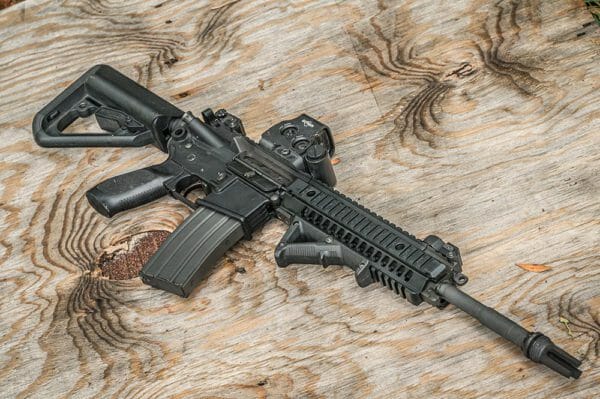
Sig Sauer Sig516 Gen 2 Upper Receiver Assembly

Whereas your standard run-of-the-mill AR-15 is a direct impingement-operated firearm, the SIG 516 instead utilizes a short-stroke piston. If you’re familiar with PWS’s piston guns, the Taiwanese T-91 assault rifle, or the Russian SKS, the same principle applies here.
Visualize the AK-47, it has a long piston attached to the bolt carrier group. The piston lies in the gas tube, and when hot expanding gasses siphoned from the detonated cartridge enter said tube, the piston drives the bolt carrier group rearward. This in turn extracts the spent casing, and then the recoil spring propels it forward to chamber a new round from the magazine.
The SIG 516 works in a very similar way, except the piston is separate from the carrier group and contained within the gas tube with its own small return spring.
Your next question should be, why?
The main advantage of using a short-stroke piston over a long-stroke one is that the mass of the reciprocating carrier group is substantially decreased. This has the effect of reducing felt recoil since there isn’t a massive weight traveling back and forth between shots.
SIG 516 Upper VS Standard AR-15 Upper
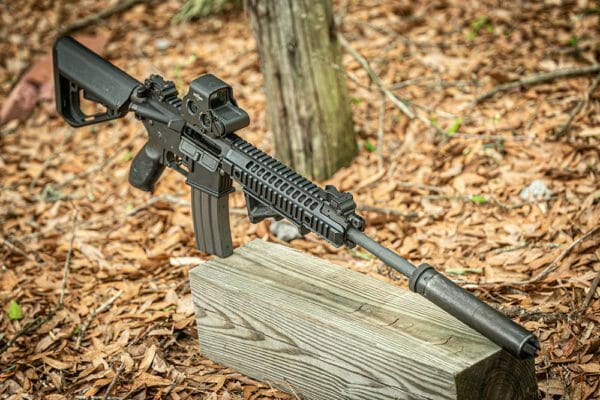
OK, but then the next question needs to be, why choose this over a standard direct-impingement setup. Primarily for reliability reasons, stemming from less sensitivity to carbon buildup and to an extent, less consistently-loaded ammunition. Though that last part is a somewhat moot point; Not because the statement is untrue, but because modern AR-makers have configured their guns to tolerate this ammunition in a number of ways. The most common way – especially among cheaper uppers – is to simply over gas the hell out of them.
To these makers’ credit, over-gassing does work. But it has some drawbacks like increased wear on components, and increased recoil impulse.
But one of the aspects of the 516 that makes it so great and reliable, is its integrated adjustable gas system. For shooters like myself who love to suppress everything they own, this is a must-have feature.
Why? Because it lets you reduce that rearward pressure to make the gun cycle normally despite the increased backpressure caused by adding a sound suppressor.
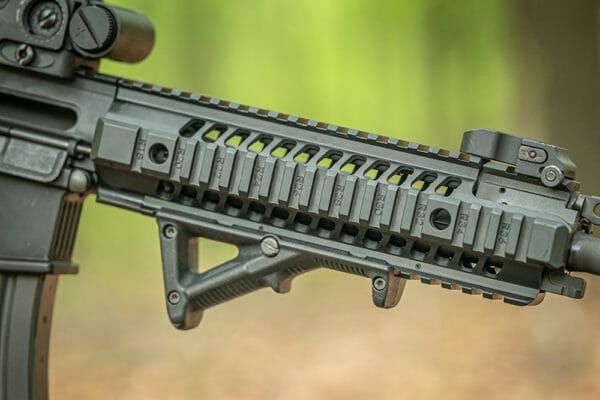
516 Features
The uppers come fairly barebones. They lack any sort of iron sights but do include a full-length Picatinny rail on top, as well as an old-school quad-rail. These uppers are (or were) available in various barrel lengths including 16, 14.5, and 12.5-inch. For the review, I chose the 14.5-inch barrel version and had a SilencerCo ASR Flash Hider pinned and welded to the barrel to bring it to the NFA-required 16-inch barrel length. Normally, I would just toss a brace on the gun and call it a day, but since I was going to run this gun suppressed primarily anyway, I figured I’d just make the muzzle device permanent.
One thing some shooters will notice is that the quad rail isn’t for standard AR-15s. This is because it needs to accommodate the adjustable gas valve at the front. And if you’re like me and think that a quad rail is a little too heavy, Lancer Industries offers carbon fiber handguards specifically for this gun – though they (predictably) aren’t cheap.
Lastly, all barrel configurations ship with an A2-style birdcage combination flash-suppressor/compensator. It doesn’t work especially well, but more than well enough to curb the recoil on the mild 5.56mm round.
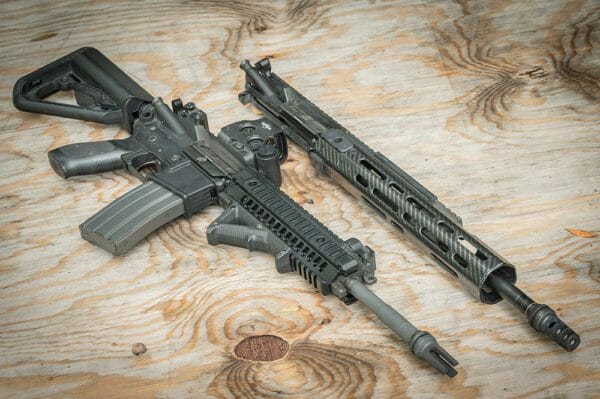
Sig516 Performance
I own two 516s, one is just an upper, while the other is a complete gun from SIG. I have fed my personal gun over 8,000 rounds without a single malfunction over several years, and in a DMR match where my primary weapon went down, I was able to successfully engage targets out to 600 yards using the standard 16-inch barrel SIG 516 carbine equipped with an Elcan Spectre Four-Power Scope.
As for the 14.5-inch upper, it has only thus far fired around 750 rounds over the course of six months, but in that time also has encountered no problems whatsoever. It doesn’t seem to care if I feed it high-end match-grade ammo, brass mil-spec rounds, or crappy Monarch re-branded steel-cased Tula .223. It just keeps running and running. As far as accuracy, the 516 upper had no problems engaging man-sized targets at 450 yards with a reflex sight, provided that a shooter did their part.
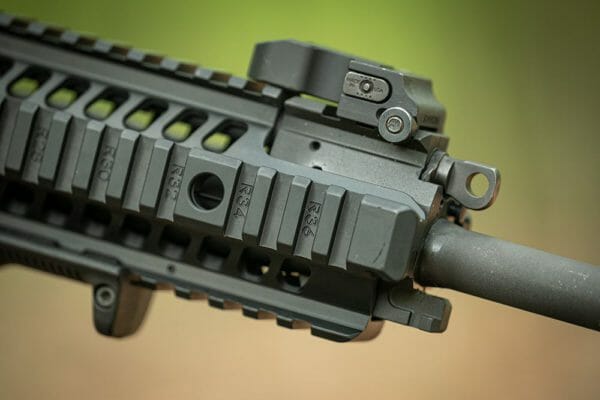
SIG516 Verdict – Pure Upgrade?
As much as I love the 516, objectively it’s not a pure upgrade over a standard DI upper. Yes, it runs cleaner, more reliably (especially with a can), and is extremely robust, but it’s also substantially heavier. The SIG 516 upper without optics or accessories tips the scales at four pounds, 15 ounces. Compare that to a modern extruded-aluminum handguard 14.5in upper which weighs right around three pounds. The extra two pounds might not seem like much, but since that weight is primarily towards the muzzle, it can feel very heavy very fast. Not to mention the fact that a DI upper will tend to be a little more accurate, but provided that a quality barrel is used on both guns, neither will produce groups larger than two MOA with quality ammo.
My opinion on the Sig Sauer Sig516 Gen 2 Upper Receiver? For shooters looking for a great suppressor host, it is rock solid – it’s just too bad that the barrel profile is proprietary since the gun would be amazing in .300blk.
Guns, Gear, and Parts as seen in this product rundown:
- Sig Sauer Sig516 Upper Receiver ~ discontinued 🙁
- Check the Secondary Market for SIG 516 Rifles or Uppers online here.
- SilencerCo Saker ASR Suppressor
- Lancer Industries SIG516 Handguard
- Tula .223. Rem Ammunition
- Eotech Holosight EXPS3 Optic
- Sig Sauer Iron Sight Set
- Lancer L5AWM Magazine
- MagPul AFG Fore Grip
- Ar-15 A2 Birdcage Flash Hider
- SilencerCo ASR Flash Hider
- Elcan Spectre Four-Power Scope
About Jim Grant
Jim is one of the elite editors for AmmoLand.com, who in addition to his mastery of prose, can wield a camera with expert finesse. He loves anything and everything guns but holds firearms from the Cold War in a special place in his heart.
When he’s not reviewing guns or shooting for fun and competition, Jim can be found hiking and hunting with his wife Kimberly, and their dog Peanut in the South Carolina low country.


piston uppers aren’t the only reason for reliability.. mostly it’s the manufacturing standards. also the AR-15 family is not designed for a PISTON set up. they also do stuff that standard DI uppers DON’T do.. like an unsupported non asymmetrical rear bolt carrier thrust DOWNWARD into the hammer and buffer lower tower junction area and then PINCHES the end of the buffer tube where normally the BC goes back in a linear travel and HAS no downward deflection. yeah AK reliable, AK’s fail the mud test according to FORGOTTEN WEAPONS, and the videos on youtube showing the tighter tolerances of… Read more »
Matt Hoover aka CRS, did some reliability testing not long before he was busted. He jammed handfuls of snow into the action of various guns. His premise was simulate a person tripping and falling while carrying and/or the weapon getting buried in snow. The AR he used would consistently fire, eve after he split the receivers and packed the lower full of snow. His theory was that there’s a positive pressure wave inside the AR once the bolt moves back far enough for the gas key to spectate from the gas tube. He also opined that this is the meaning… Read more »
The AR is an internal piston, not a true DI..If your cases were sticking in your DPMS, then the chamber was out of spec..External piston rifles have sharper recoil, increase weight and come with their own problems in the AR rifle platform..The original Stoner internal piston does not need increased cleaning, it does require a good lube and plenty of it..
Several years ago Sig had a big sale on 14.5″ uppers. I’m guessing a combination of military over-run and a large quantity of arm braces they wanted to get rid of since they were selling them as a package. I think the former because it came with a full auto bolt carrier and the latter because the braces were either not moving well or they saw the writing on the wall. I’m still vacillating between a Form 1 SBR on the 516 (what Jim Grant should have done) or adding a second stamp to the Colt.